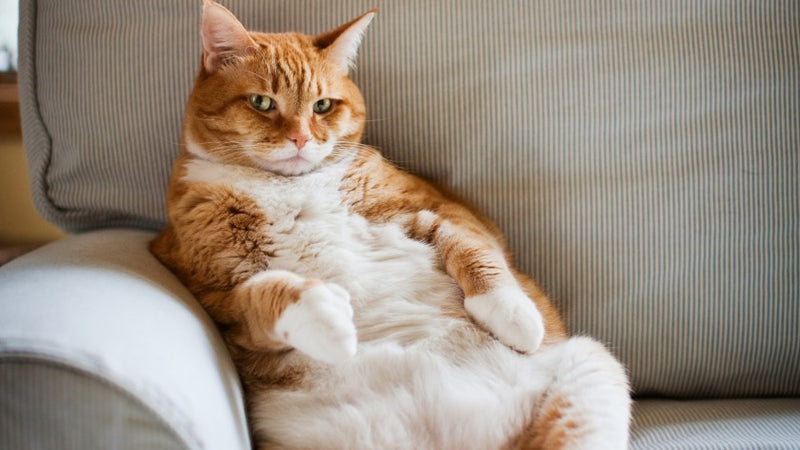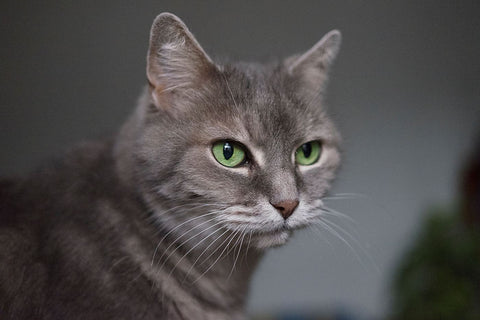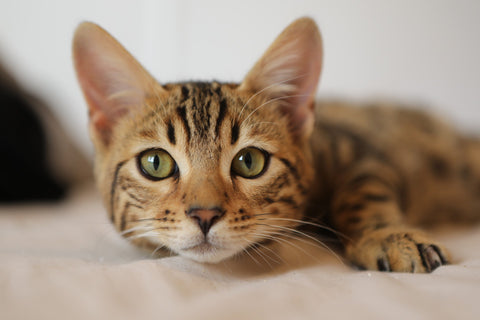
Nothing is better than curling up with our kitties and enjoying their purring and kneading paws. We wish these moments could last forever! While we can’t make them last forever, we can make them last as long as possible by taking care of them the best way we can and providing them the longest, healthiest, happiest lives that we possibly can. One of the best ways to keep our cats healthy and increase their lifespan is by preventing obesity in our cats.
Unfortunately, the “Garfield” physique for cats has become accepted, and even the sought after body condition in cats. According to The Association for Pet Obesity Prevention (APOP) surveys, 60% of cats are obese.

Feline obesity can decrease a cat’s lifespan and lead to a reduced quality of life. Keeping our cats fit, not fat, is one of the best ways to get more time with them. Knowing the symptoms of feline obesity and how to prevent them is among our key responsibilities as guardians of our cats. So, where can you learn more about obesity in cats and how to prevent it? The Association for Pet Obesity Prevention (APOP) is one of the veterinary industry leaders in obesity prevention and education, committed to making the lives of pets healthier.
“Obesity is the number one health threat pets face, and the most important pet health decision owners make each day is what and how much they feed.” — Dr. Ernie Ward, Founder APOP.
What do feed cats?
For most cat guardians, “what to feed,” is a common concern and can be a very confusing topic. If you ask 100 veterinarians, pet owners, and experts, it seems as though you might get 100 different answers about the right food to feed. Knowing where to go for the best information can be confusing and even frustrating. The fact is, the best food for your cat is the one they will eat! You can have the most premium, wholesome and complete food possible and thousands of hours of research behind this choice, but if your cat won’t eat it, they won’t benefit from even the best diet. So, we should consider first not what we feed our cats, but what they need to meet their nutritional requirements. Understanding the foundational aspects of feeding your cat is the first place to start, even before thinking about what to feed.
How much to feed is another area where APOP has come to the rescue! Knowing how much to feed your cat is the foundation of preventing obesity, as well as knowing your cat’s ideal weight range. Regardless of the food you feed your cat, these are the basics on which you build. Your veterinary team is a great resource to lean into for conversations regarding your cat’s caloric needs and ideal weight.
Ideal weight in cats, like humans, does not just focus on the number on the scale, but also the overall body condition. Body condition can be assessed through manual and visual evaluation of your cat’s general fat excess. Learning how to use the body condition scoring (BCS) system to evaluate your cat’s fat storage is essential throughout their lifetime. Nutritional needs for cats change over time and with each life stage, so work with your veterinary team to learn BCS assessment and monitoring, and be sure to discuss your cat’s weight and nutritional plan with your veterinary team at every veterinary visit.

Alongside body condition score (BCS), monitoring weight in cats can be vital to preventing obesity and also aid in the early detection of health concerns. How do you weigh your cat? There are a few methods, but the best way is to teach them to weigh themselves!
What happens if you find that your cat is obese or experiencing excess fat storage?
First, consult with your veterinary team on healthy weight loss goals for your cat. They can also ensure your cat is healthy for weight loss and that you are meeting nutritional goals. Have a plan for follow-up communication to ensure close monitoring by your veterinarian. Ensure you are comfortable with your plan and that you develop a goal you feel comfortable with. Compliance for weight loss in cats depends heavily on you as their guardian. And, keep in mind, diet is not the only way to prevent and combat obesity!
Cat zoomies are the best, right? What about the little rabbit kicks on their side? How majestic are our cats when we watch them jump and climb, stretch out long, or stand on their hind legs to check out something high up? Our cats are natural-born athletes, built for climbing, pouncing, and wrestling with strength and agility. Yet, we often forget their athletic side and consider cats to be “low maintenance, even lazy! Sure, cats sleep. A lot. But they are built for small bursts of, well, basically everything. Cats generally follow a ‘hunt, catch, kill, eat, groom, sleep, and repeat’ pattern in life. So, with this knowledge, we can tap into our cat’s most playful times of the day and exploit their natural cycle. Watch your cat for a few days to determine when they are most active. This is likely to be early in the morning, before meals, and in the evening.
Once you identify your cat’s natural play cycles, you can use this time to help exercise your cat. Think about ways to help get your cat climbing and moving to burn calories. Again, with the clearance of your veterinarian. A few ideas are to feed your cat with a feeder toy, feeder mice hidden throughout the house, and if you can commit the time, try tossing kibbles down the hall, or create a trail up stairs or over obstacles to increasing movement while eating. You can even consider training your cat to walk on a leash. Get creative, every calorie counts!
Lastly, stay up to date on the latest studies, feeding trends, and expert advice: Sign Up — Association for Pet Obesity Prevention. If you need individualized help with weight loss and nutrition, consider joining Coach My Cat. You can schedule individual video calls with a specialized health coach who can help interpret and expand on your veterinarian’s recommendations, answer questions about nutrition and health, or help create a customized weight loss plan for your cat. If your cat has been diagnosed with obesity by their veterinarian, apply to the Basepaws Research Program and help us expand our knowledge base and understanding of genetic predisposition to obesity in cats. We can’t guarantee the longevity of our cats. Still, we can help them to get the best out of their “nine lives” by preventing obesity and, in turn, increasing their quality of life, decreasing the likelihood of cancer, diabetes, osteoarthritis, and other obesity-related conditions.
Your cat deserves the best, and you want to give them the best in life. Preventing obesity, promoting a healthy lifestyle, and increasing physical activity are a few of the best things we can do as guardians to get the most time with our cats.



